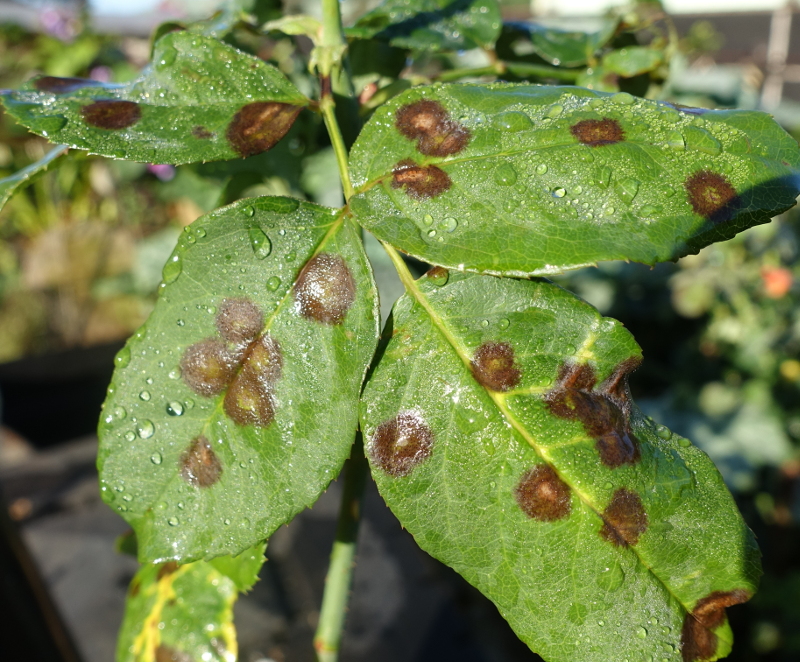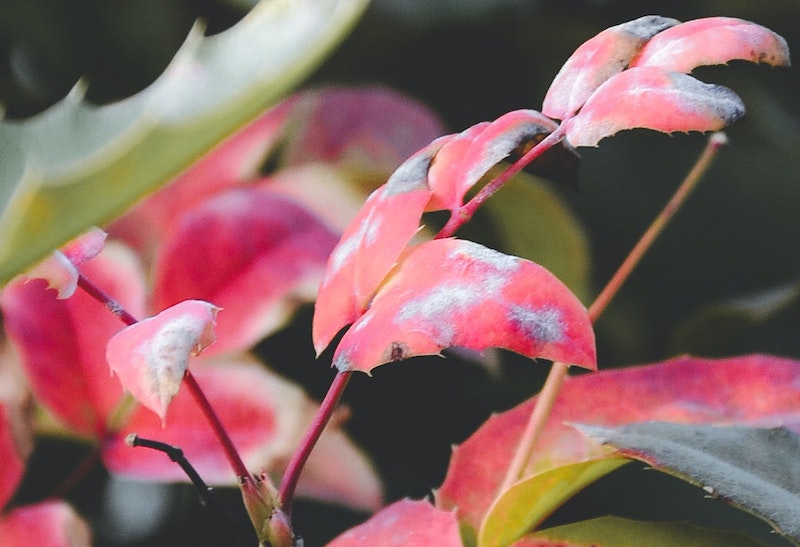Ensure that rose greets you daily with lush, fragrant blooms by supporting its good health. To do this, observe for disease symptoms and treat them when necessary. Aim to prevent diseases by providing ample air circulation, practicing good garden hygiene, and keeping up on pruning.
Common ailments include black spot, canker, and powdery mildew. While bacteria and fungi cause many plant diseases, fungi cause these three. If not treated promptly, they can harm the rose’s health and occasionally lead to death. Items used to prevent and treat blackspot, canker, and powdery mildew include vinegar, baking soda, Bordeaux mixture, commercially made organic fungicides containing copper, and horticultural oils such as neem oil.
Rose Black Spot
Black spot (Marssonina rosae or Diplocarpon rosae) is a common fungal disease that affects roses. This fungal disease forms black spots all over the foliage of rose bushes causing the leaves to turn yellow and fall off. If left untreated, all of the leaves can fall off and the fungus can weaken the entire rose bush.

The spores of black spot travel with the help of water, so black spot disease thrives during cool moist weather conditions. Mild wet spring days and moist dewy nights are prime conditions for black spot disease to attack and spread. Once the fungus becomes active, it cannot be stopped without fungal controls. Prevention and prompt intervention when first spotted are critical to help keep your roses healthy and beautiful.
Identifying Black Spot
The first signs of black spot will begin to appear on the lower leaves of the rose bush. Circular black spots on the upper sides of the leaves will develop. Sometimes the spots are so big that they merge together. The diseased leaves will turn yellow and eventually fall off of the plant. If left untreated, the fungus moves upward and the entire plant can lose its leaves.
Black spot not only affects the leaves of roses but the canes as well. Old and new canes can be infected with black spot disease. Black spot on canes will look like purple or black dots.

Treating Black Spot
Once your rose shrub has black spot, even after you have treated the plant, the spots on the leaves will remain until all diseased leaves have fallen off. Prevention is key when treating black spot on roses. Planting your rose in an area that gets full sunlight will help to keep the leaves dry. Spacing out rose bushes allows for good air circulation, which also helps to dry out the foliage and prevent the disease from spreading. Pruning the diseased canes is also very important.
During the growing season, avoid getting the leaves wet when watering. It is a good idea to spray your roses in the spring with a fungicide and continue treating every two weeks so that new leaves are protected from the start. A combination of baking soda and water can also be applied weekly for prevention.
Once you see black spots on your rose leaves, you need to address the issue immediately. Begin by pruning away all of the infected leaves and infected stems. Dispose all of the infected material. Once that is done you will need to spray the entire plant, both above and below the leaves and stems with a commercial fungicide or a homemade solution. If the black spot returns, you may need to spray your roses weekly.
If you choose to stay away from chemical sprays, there are many DIY methods of treatments. You can make a Bordeaux mix which will also help to repel some insect pests. A baking soda and soap spray can also help with powdery mildew issues. Neem oil is an organic fungicide and pesticide derived from the seeds of the neem plant. Sulfur powder is also an option.
Rose Canker
Canker is characterized by a fungi that infects via openings in the rose’s stems or canes. These openings may be the result of pruning or damage to the plant. Cankers, or abscesses, develop along the stem and if allowed to continue to grow around the stem, can kill it. To prevent these growths from forming, routinely prune, fertilize, water, and aerate rose bushes; a healthy plant can resist disease. Once infected, however, prune and discard infected material, and treat with sulfur powder, Bordeaux mixture, or a commercial fungicide containing copper.
Identifying Canker
Cankers are small diseased abscesses ranging in color from black to yellow that grow along rose stems. They may grow significantly as the disease progresses.
Treating Canker
After observing signs of rose canker, use disinfected shears to prune the diseased canes. Continue to do this, cleaning your sheers in between cuts until all of the damaged stems have been trimmed. Dispose of the diseased material, and then treat rose with Bordeaux mixture, sulfur powder, or a commercial fungicide containing copper.
Rose Powdery Mildew
A pathogenic fungus, Podosphaera pannosa, causes powdery mildew. If your rose’s verdant foliage abruptly looks as if it has been dusted with white or grayish powdered sugar, it’s likely your beautiful rose bush has been infected by it. While this disease can hamper a rose’s health, especially if it recurs often, if treated promptly with pruning and fungicides, you can significantly minimize the overall risk. Prevention measures include providing good air circulation, pruning in spring, keeping the foliage dry, and watering regularly.
Identifying Powdery Mildew
Powdery mildew is characterized by the appearance of a light white or gray powder-like substance on a rose’s foliage, stems, and buds. Over time the mildew may darken to a brownish color.

Treating Powdery Mildew
Prune diseased canes and remove the infected material using sterilized pruning shears. Then, treat with a horticultural oil such as neem oil, sulfur powder, Bordeaux mixture, or a fungicide containing copper.
Rose Disease Chart
|
Disease |
Identifying |
Treating |
|
Rose Black Spot |
Dark spots on foliage/stems |
Prune, apply fungicides & provide air circulation |
|
Rose Canker |
Lesions on stems |
Prune, fungicides & air circulation |
|
Powdery Mildew on Rose |
White spots on leaves |
Prune, fungicides & air circulation |
Sources:
"Rose Diseases." Clemson University Cooperative Extension Service. hgic.clemson.edu
"Rose Diseases: Identification and Management." The University of Tennessee System. plantsciences.tennessee.edu
 |
Author Suellen Barnes - Published 4-25-2023 |
